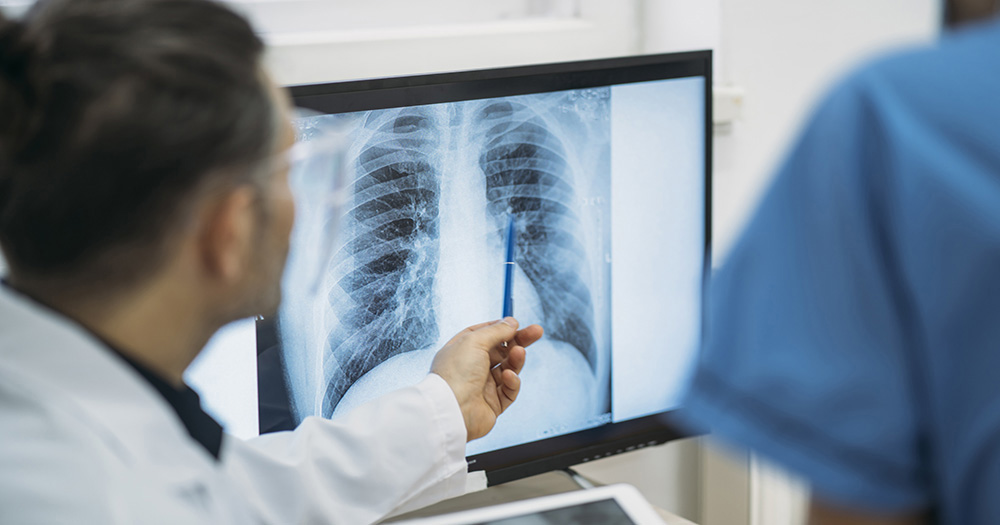Develop the skills to become a radiologic technologist, and you’ll join the third-largest
group of healthcare professionals—surpassed in number only by physicians and nurses.
Before jumping into your program, head to the Texas Success Initiative (TSI) website
and complete all of the required components. Not sure which to do? Reach out to the
WCJC’s Admissions Office for help.
Fill out the one-page Radiology Application found in the application packet. As part of the application, you’ll need to write a one-full-page essay focused on
one of the following prompts:
- Why is radiology the career field you’ve chosen to pursue?
- Define adversity you have positively managed.
- Describe (with specifics) your leadership ability.
Be sure your essay is written in size 12 Times New Roman or Garamond font, on a page
with 1-inch margins. Essays should include a reference to the radiologic technology
field, a personal statement of interest in imaging, and a title.
Collect and Submit Your Transcripts
You’re required to submit transcripts from any institution (including WCJC) that you’ve
previously attended. Send official transcripts to the Registrar’s Office and unofficial transcripts to the Radiologic Technology department. If you’ve attended
any other colleges, you’ll need to complete and submit a degree evaluation request form at least 30 days before you apply to the program. This is a timely process and it
is the student’s responsibility to make sure the program has received the evaluation
prior to the application deadline.
All radiologic technology students are required to take, complete, and earn a grade
of “C” or higher in the following prerequisite courses: BIOL 2401 Human Anatomy and
Physiology I and BIOL 2402 Human Anatomy and Physiology II by the application due
date. There is no timeframe for the prerequisite courses. Additionally, you should
complete the following general education courses: MATH 1314 (College Algebra), ENGLISH
1301 (English Composition), PSYCHOLOGY 2301 (Introduction to Psychology), and Language,
Philosophy, & Culture, OR Creative Arts to satisfy graduation requirements for the
program. They are not required to be completed prior to application but will give
you additional points toward admission to the program. Students are chosen based on
a point system.
Gather Immunization Documentation
In order to participate in clinical or coursework at WCJC, you’ll need to provide
proof of completion of the Hepatitis B vaccine series (the series takes six months
to complete). Work with your doctor to gather proof of immunizations, then submit
your documents to the department. The students will be required to provide a Titer
test for immunity (Igg) after acceptance into the program.
Submit Required Forms
Your application packet should include a number of forms, including the following:
- The essential abilities technical standards form and the ARRT eligibility form (both
found in your application packet).
- A copy of your ACT scores, with a composite of at least 18 enhanced taken within the
last five years. Preference is given to those who score 20 or higher.
- A brief summary of your work history. Admissions points are given to those with at least six months of medical experience,
including volunteering.
Want to learn more about radiologic technology?
Informational Session
It is mandatory that you attend an Information Session. The information sessions are
offered from January to May of each year. Call 979-532-6391 and speak to Lori Baumgarten, Program Secretary, to sign up for a session.
Background Check
In the radiologic technology program at WCJC, you’ll get hands-on training directly
in clinical facilities. To ensure the safety of all involved, you are required to
complete and pass a background check and a drug screening. Make an appointment with
the Program Director, Sharla Walker, should you have any questions regarding criminal
offense mandates by the ARRT and Texas Medical Board.
Is a Radiography Program Right for You?
Most radiologic technologists enter the profession as radiographers. In this role,
you’ll capture images of patients’ internal organs, soft tissues, and bones using
X-ray equipment. You also might assist radiologists with a range of procedures, such
as fluoroscopic imaging or gastrointestinal exams that require the use of contrast
media.
You’ll probably work in a hospital, physician’s office, outpatient care center, or
laboratory. In most cases, you'll split your work between technological tasks and
interactions with patients.
A career as a radiographer is challenging and rewarding. Working in this field, you’ll
be an important part of a medical team that diagnoses and treats patients who have
a range of diseases and injuries.
With advanced education, you can also pursue a career in bone densitometry, cardiac
or vascular interventional radiography, computed tomography, mammography, magnetic
resonance imaging, nuclear medicine or sonography. Radiation therapists and medical
dosimetrists are technologists who specialize in radiation therapy, which is the application
of radiation to treat cancer and other diseases.
Radiographers gain certification through the largest certification agency, the American Registry of Radiologic Technologists®, has more than 300,000 registrants. Wages of radiologic technologists are competitive
with other health professionals who have similar educational backgrounds. Visit the U.S. Bureau of Labor Statistics to see current trends in R.T. wages.
